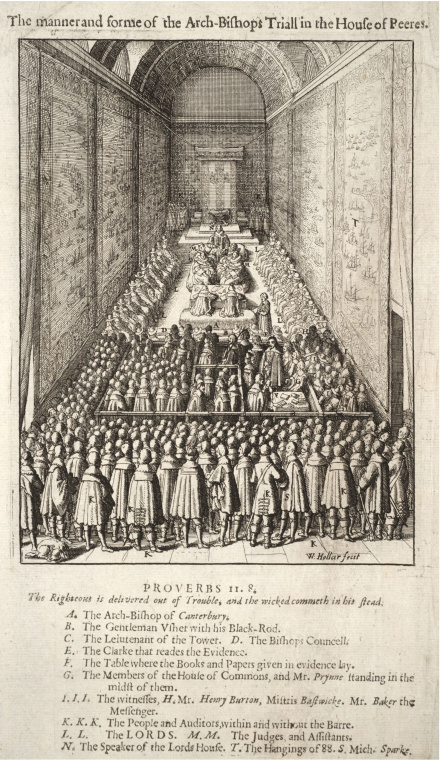William Laud, 1573-1645, was Archbishop of Canterbury during the reign of King Charles I of England and regarded by many as an Anglican martyr. Appointed as Archbishop in 1633, Laud shared Charles I’s “high church” views of church governance by bishops and uniformity of worship according to the Book of Common Prayer. This was in sharp contrast to the Puritan factions in the Church of England at the time who took a more Calvinistic approach to worship and a Presbyterian form of government.
Note that “high church” at the time meant a high view of governance, such as bishops. It didn’t mean the “high church” that we equate today with a more Anglo-Catholic form of worship, namely incense, bells, chanting, and other liturgical elements. Laud did, however, bring back altars and communion rails after Puritan-leaning clergy removed them from their churches and demanded that clergy use the Book of Common Prayer for all worship services.
Laud thought that Puritanism was a threat to the episcopacy and to the Church as a whole and pursued Puritans in the infamous Star Chamber, where self-incrimination could be compelled and torture was frequently used. Those who were convicted of the crime of Sedition and Libel had their nose or an ear cut off and had “SL” branded on their cheek, for “Sedition and Libel.” Under Laud’s tenure the SL became known as the “Sign of Laud.”
To say that Laud was unpopular was an understatement. A popular saying at the tim e was, “Give great praise to the Lord and little Laud to the Devil.” Finally in 1640 the Puritan forces in Parliament had him arrested. He was imprisoned for four years and finally tried, not by a court, but by Parliament (Charles I had control of the courts and the outcome would not have been satisfactory to his opponents.) A famous etching of the trial is reproduced below along with the quote from Proverbs, “The righteous are delivered from trouble and the wicked get into it instead.”
(Prov. 11:8) Laud was convicted by a bill of attainder by Parliament instead of a jury.
Laud was executed on Tower Hill on January 10, 1645. Laud preached his own funeral sermon on the scaffold, prefacing his comments with the observation that “this is an uncomfortable time to preach.”
His benefactor, Charles I, would, of course, meet the same end in 1649. Laud’s views of the episcopacy and other high church principles survived after the Restoration, and other Anglican divines known as “Laudians”, carried on his work for future generations of Anglicans.
The Reverend Lucius Waterman in 1912 summed up Laud’s contribution best when he observed that:
That we have our Prayer Book, our Altar, even our Episcopacy itself, we may, humanly speaking, thank Laud …… That our Articles have not a Genevan sense tied to them and are not an intolerable burden to the Church, is due to Laud. ….. . Laud saved the English Church …… The English Church in her Catholic aspect is a memorial to Laud.” (from here)
He continues, quoting Gladstone:
Laud as a Churchman has lasted. He lives to-day. His opponents have mostly disappeared from off the earth. They have left consequences, but no representatives. Laud has both.
From the 1979 BCP:
Keep us, O Lord, constant in faith and zealous in witness, that, like your servant William Laud, we may live in your fear, die in your favor, and rest in your peace; for the sake of Jesus Christ your Son our Lord, who lives and reigns with you and the Holy Spirit, one God, for ever and ever. Amen



